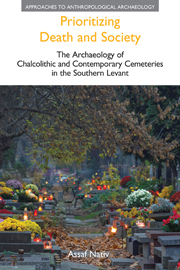 Prioritizing Death and Society
Prioritizing Death and Society Book contents
- Frontmatter
- Dedication
- Contents
- List of figures
- List of tables
- Acknowledgements
- Part I Introduction
- Part II Chalcolithic cemeteries
- 3 Chalcolithic cemeteries: winks, twitches and faked twitches
- 4 Isolated in the landscape: single-cave cemeteries
- 5 Multiple components: multiple-cave cemeteries
- 6 Dark, damp and deep: karstic-cave systems
- 7 Funerary structures
- 8 Exceptions, outliers and misfits
- 9 Structured deposition and depositional structures
- Part III Contemporary cemeteries
- Part IV Conclusion
- Appendix: Gazetteers of cemeteries
- Notes
- Bibliography
- Index
6 - Dark, damp and deep: karstic-cave systems
from Part II - Chalcolithic cemeteries
- Frontmatter
- Dedication
- Contents
- List of figures
- List of tables
- Acknowledgements
- Part I Introduction
- Part II Chalcolithic cemeteries
- 3 Chalcolithic cemeteries: winks, twitches and faked twitches
- 4 Isolated in the landscape: single-cave cemeteries
- 5 Multiple components: multiple-cave cemeteries
- 6 Dark, damp and deep: karstic-cave systems
- 7 Funerary structures
- 8 Exceptions, outliers and misfits
- 9 Structured deposition and depositional structures
- Part III Contemporary cemeteries
- Part IV Conclusion
- Appendix: Gazetteers of cemeteries
- Notes
- Bibliography
- Index
Summary
Only two examples of Chalcolithic cemeteries in active karstic systems are known to date: the Peqi'in Cave in the Upper Galilee (Gal et al. 1997, 1999, 2007, 2011) and the Nahal Qanah Cave in the Samarian Mountains (Gopher & Tsuk 1996). Unlike other burial-cave cemeteries that are found fairly close to each other, these two are located almost 100 km apart. While this may be due to a variety of factors (chance of recovery, association with sparsely settled areas, etc.), it may also suggest that these two caves differed along culturally significant lines as well. This is an issue to which we shall return towards the end of the chapter. First, however, a concise review of both cases will be presented with particular emphasis on the skeletal remains, modes of deposition and the composition of the funerary assemblages. The remainder of the chapter will consider their lines of similarity and difference.
Peqi'in Cave
Peqi'in Cave is the northernmost Chalcolithic cemetery known to date, located in the Upper Galilee. It was discovered during road construction, and was subsequently excavated from May to August 1995. The largest and richest Chalcolithic funerary assemblage known thus far was found in this cave, consisting of an extraordinary variety of artistic/symbolic expressions, materials and the osseous remains of many hundreds of individuals. This account will focus on a few aspects of the data; the reader is encouraged to explore the preliminary reports published so far (Gal et al. 1997, 1999, 2007, 2011).
- Type
- Chapter
- Information
- Prioritizing Death and SocietyThe Archaeology of Chalcolithic and Contemporary Cemeteries in the Southern Levant, pp. 81 - 87Publisher: Acumen PublishingPrint publication year: 2013
